Validation of turbine noise prediction tools with acoustic - MTU Aero ...
Validation of turbine noise prediction tools with acoustic - MTU Aero ...
Validation of turbine noise prediction tools with acoustic - MTU Aero ...
You also want an ePaper? Increase the reach of your titles
YUMPU automatically turns print PDFs into web optimized ePapers that Google loves.
<strong>Validation</strong> <strong>of</strong> <strong>turbine</strong> <strong>noise</strong> <strong>prediction</strong> <strong>tools</strong><br />
<strong>with</strong> <strong>acoustic</strong> rig measurements<br />
Dominik Broszat ∗ , Detlef Korte<br />
<strong>MTU</strong> <strong>Aero</strong> Engines GmbH, Department <strong>Aero</strong>dynamics, <strong>Aero</strong>elasticity, <strong>Aero</strong><strong>acoustic</strong>s Turbine<br />
Dachauer Strasse 665, D-80995 Munich, Germany<br />
Ulf Tapken<br />
German <strong>Aero</strong>space Center (DLR), Institute <strong>of</strong> Propulsion Technology, Berlin, Germany<br />
Mathias Moser<br />
Graz University <strong>of</strong> Technology, Institute <strong>of</strong> Thermal Turbomachinery and Machine Dynamics,<br />
Graz, Austria<br />
Well-defined measurement data are <strong>of</strong> key importance for the validation and calibration<br />
<strong>of</strong> numerical methods. Accordingly, an <strong>acoustic</strong> test rig resembling the last stage <strong>of</strong> a low<br />
pressure <strong>turbine</strong> (LPT) <strong>of</strong> a modern turb<strong>of</strong>an engine has been established at the Graz<br />
University <strong>of</strong> Technology in Graz, Austria <strong>with</strong>in the frame <strong>of</strong> the European Research<br />
Project VITAL. It has been designed to allow for a clear separation <strong>of</strong> the contributors to<br />
<strong>turbine</strong> <strong>noise</strong> by a systematic selection <strong>of</strong> the individual blade numbers <strong>of</strong> the subsequent<br />
rows. This setup permits the classification <strong>of</strong> the measured or computed tones <strong>with</strong> respect<br />
to their origin and source mechanism. Within the VITAL project, several <strong>acoustic</strong> test<br />
campaigns have been carried out: a datum (or reference) configuration as well as variations<br />
<strong>of</strong> the axial gapping between the stator, rotor, and the EGV. These give insight into the<br />
relative weighting <strong>of</strong> the above mentioned source mechanisms and the influence <strong>of</strong> distance<br />
variations on <strong>noise</strong> generation.<br />
Abbreviations:<br />
ADP <strong>Aero</strong>dynamic Design Point LPT Low Pressure Turbine<br />
BPF Blade Passage Frequency OP Operating Point<br />
EGV Exit Guide Vane PWL Sound Power Level<br />
EO Engine Order RMA Radial Mode Analysis<br />
FFT Fast Fourier Transform SNR Signal-to-Noise Ratio<br />
GTF Geared Turb<strong>of</strong>an STTF Subsonic Test Turbine Facility<br />
IGV Inlet Guide Vane TEC Turbine Exit Case<br />
LEE Linearized Euler Equations VITAL EnVIronmenTALly Friendly <strong>Aero</strong> Engine<br />
I. Introduction/ motivation<br />
Within the last decades, the <strong>noise</strong> radiated from an aircraft engine has been reduced drastically. This<br />
can be attributed both to source <strong>noise</strong> reduction and passive measures to reduce the <strong>noise</strong> radiated to the<br />
far field. The latter refers to a maximization <strong>of</strong> the <strong>acoustic</strong>ally lined area <strong>with</strong>in the engine inlet and bypass<br />
duct. In parallel, both jet and fan <strong>noise</strong> have been reduced in the course <strong>of</strong> constantly increasing bypass<br />
ratios motivated by the maximization <strong>of</strong> the propulsion efficiency <strong>of</strong> the engine.<br />
∗ Corresponding author, PhD, email: dominik.broszat@mtu.de<br />
1 <strong>of</strong> 13<br />
American Institute <strong>of</strong> <strong>Aero</strong>nautics and Astronautics
However, due to these <strong>noise</strong> reductions <strong>of</strong> the main contributors to engine <strong>noise</strong>, other components have<br />
recently gained importance, e. g. the <strong>turbine</strong> (and especially the low pressure <strong>turbine</strong> (LPT)) <strong>with</strong>in the<br />
rear arc. This is especially true in operating conditions where the <strong>noise</strong> floor <strong>of</strong> the other components is<br />
fairly low, e. g. at approach power (compare figure 1), such that the LPT can become the dominating <strong>noise</strong><br />
source <strong>with</strong>in a certain frequency range. Related to current engine developments, this fact gains even more<br />
importance in the case <strong>of</strong> geared turb<strong>of</strong>an (GTF) designs where fan <strong>noise</strong> can be reduced even more compared<br />
to conventional applications and thus the relative weighting <strong>of</strong> the LPT increases.<br />
(a) (b)<br />
Figure 1. Contributors to aircraft <strong>noise</strong> at take<strong>of</strong>f and approach (schematic) [Ref. 1]<br />
Motivated by this growing importance <strong>of</strong> LPT <strong>noise</strong> in modern aircraft engines and for the validation <strong>of</strong><br />
analytical and numerical <strong>tools</strong> used for the design and assessment <strong>of</strong> turbomachinery, an <strong>acoustic</strong> test rig<br />
has been established and put into operation at the Graz University <strong>of</strong> Technology in Graz, Austria <strong>with</strong>in<br />
the European research project VITAL (EnVIronmenTALly Friendly <strong>Aero</strong> Engine). It has been carefully<br />
designed to allow for a clear separation <strong>of</strong> the individual <strong>noise</strong> contributors <strong>with</strong>in a 1 1<br />
2<br />
stage LPT at<br />
minimum disturbances. In addition to the ability to determine the <strong>noise</strong> generation origins and the relative<br />
weighting <strong>of</strong> the individual interaction mechanisms in relation to the overall LPT <strong>noise</strong> for a reference<br />
configuration, several <strong>acoustic</strong> measurement campaigns have been conducted involving geometric variations<br />
as well as <strong>acoustic</strong> measures to reduce both the <strong>noise</strong> generation and its radiation from the LPT exit.<br />
Within this paper, the setup <strong>of</strong> the <strong>acoustic</strong> test facility, a short description <strong>of</strong> the measurement campaigns,<br />
the general features <strong>of</strong> the <strong>tools</strong> used for predicting the LPT <strong>noise</strong>, and a comparison <strong>of</strong> the experimental<br />
and numerical results will be given.<br />
II.A. General setup<br />
II. Design <strong>of</strong> the <strong>acoustic</strong> test rig<br />
In this section, only a brief description <strong>of</strong> the test rig setup will be given, a more detailed version is available<br />
in Ref. 2. Figure 2 shows a sectional drawing <strong>of</strong> the STTF (Subsonic Test Turbine Facility) located <strong>with</strong>in<br />
the laboratory <strong>of</strong> the Graz University <strong>of</strong> Technology. As indicated by the arrow, the flow enters the rig<br />
through a spiral inlet casing in which it is turned into the axial direction <strong>of</strong> the rig. To cancel the remaining<br />
swirl, a deswirler unit has been included ahead <strong>of</strong> the turbomachinery section.<br />
The center part <strong>of</strong> the rig contains the 1 1<br />
2<br />
stage LPT, i. e. one <strong>turbine</strong> stage consisting <strong>of</strong> a stator and a<br />
rotor plus an inlet (IGV) and exit guide vane (EGV or TEC). For the ease <strong>of</strong> assembly and disassembly, the<br />
rotor is attached to an overhung-type shaft connected to a water brake to adjust the rpm <strong>of</strong> the LPT. By this<br />
design, both the turbomachinery parts and the downstream <strong>acoustic</strong> test section can be easily separated and<br />
modified. The corresponding airfoil counts <strong>of</strong> the four rows are listed in table 1. As mentioned above, they<br />
have been carefully chosen to allow for the clear determination <strong>of</strong> the <strong>noise</strong> generation origin <strong>of</strong> propagating<br />
<strong>acoustic</strong> modes.<br />
For the <strong>acoustic</strong> analyses, an array <strong>of</strong> flush-mounted microphones has been included on both the inner<br />
and outer annular duct walls downstream <strong>of</strong> the TEC. To reduce the number <strong>of</strong> sensors, three microphone<br />
plates <strong>with</strong> linear arrays have been positioned equally spaced on the circumference <strong>of</strong> a 360 ◦ rotatable duct<br />
2 <strong>of</strong> 13<br />
American Institute <strong>of</strong> <strong>Aero</strong>nautics and Astronautics
Figure 2. General arrangement <strong>of</strong> STTF <strong>acoustic</strong> rig<br />
Table 1. Airfoil counts <strong>of</strong> STTF rig<br />
IGV S1 B1 EGV<br />
83 96 72 15<br />
section. A sectional drawing <strong>of</strong> this part <strong>of</strong> the rig and a closeup <strong>of</strong> one <strong>of</strong> the microphone plates can be seen<br />
in more detail in figure 3.<br />
(a) <strong>acoustic</strong> test section <strong>of</strong> STTF rig (b) microphone plate<br />
Figure 3. Sectional drawing <strong>of</strong> <strong>acoustic</strong> test section and closeup <strong>of</strong> microphone plate<br />
3 <strong>of</strong> 13<br />
American Institute <strong>of</strong> <strong>Aero</strong>nautics and Astronautics
As can be seen, the microphones have been equally spaced in the axial direction and have been arranged<br />
in two lines to reduce the axial extent. Based on the assumption that the mean aerodynamic and aero<strong>acoustic</strong><br />
field are time-invariant for the duration <strong>of</strong> one test campaign, this setup using a traversable duct section<br />
permits the recording <strong>of</strong> the full circumference <strong>with</strong> a drastically reduced number <strong>of</strong> sensors. Finally, at the<br />
downstream end <strong>of</strong> the <strong>acoustic</strong> test section, the flow is redirected again into the vertical direction and leaves<br />
the laboratory through an exhaust stack at ambient conditions.<br />
Concerning the aerodynamic design, the LPT stage has been designed to represent the last stage <strong>of</strong> an<br />
LPT <strong>of</strong> a modern commercial aero engine at approximately half scale. With respect to the characteristic<br />
small expansion <strong>of</strong> the flow path at the rear stages <strong>of</strong> a typical engine, the cylindrical annular duct cross<br />
section motivated by <strong>acoustic</strong> reasons can be justified. Although designed for an aero design point (ADP), the<br />
rig has been operated at the three <strong>noise</strong> certification operating points (OP) approach, cutback, and sideline<br />
which are related to the ADP by the following factors (compare Table 2) to represent realistic operating<br />
conditions.<br />
Table 2. Rig operating points in relation to ADP [Ref. 2]<br />
parameter ADP Sideline Cutback Approach<br />
total pressure ratio [%] 100 97 85 73<br />
mass flow [%] 100 95 75 50<br />
shaft speed [%] 100 97 91 71<br />
shaft power [%] 100 87 48 16<br />
II.B. <strong>Aero</strong>dynamic and <strong>acoustic</strong> measurements<br />
The aerodynamic conditions <strong>with</strong>in the test rig have been determined at several axial positions as indicated<br />
in the sketch in figure 4. In the inlet plane (plane 0) to the turbomachinery stage, the inflow is assumed to be<br />
circumferentially and radially uniform, and the total pressure has been recorded by a Kiel probe at 5 radial<br />
locations. Together <strong>with</strong> the total temperature, this value has been used to normalize the measurements in<br />
the downstream planes to cancel slight variations in the operating conditions (mainly due to variations <strong>of</strong><br />
the inflow characteristics). Behind the IGV, in plane A, five-hole probe measurements have been performed<br />
covering 4 sectors <strong>of</strong> 24 ◦ azimuthal extension on the circumference. Within these sectors, 21 radial and 17<br />
axial positions have been recorded starting approximately 4 mm from the duct walls (due to the dimensions<br />
<strong>of</strong> the probe).<br />
Figure 4. <strong>Aero</strong>dynamic measurement planes in STTF rig<br />
4 <strong>of</strong> 13<br />
American Institute <strong>of</strong> <strong>Aero</strong>nautics and Astronautics
Figure 5 shows an exemplary plot <strong>of</strong><br />
the Mach number distribution in these<br />
sectors at approach. Apart from variations<br />
in the radial direction, the wakes <strong>of</strong><br />
the IGVs can be clearly observed.<br />
In the downstream planes B and C<br />
(downstream <strong>of</strong> the rotor and TEC, respectively),<br />
only 1 pitch <strong>of</strong> the corresponding<br />
upstream stator row has been traversed.<br />
Results <strong>of</strong> these flow measurements<br />
can be found in Ref. 3. As will be<br />
mentioned later on, these aerodynamic<br />
measurements have been <strong>of</strong> great importance<br />
for the comparison <strong>with</strong> the numerical<br />
simulations. In addition, static pressure<br />
taps have been placed on the EGV<br />
and the inner and outer duct walls <strong>with</strong>in<br />
the <strong>acoustic</strong> measurement section.<br />
Concerning the <strong>acoustic</strong> measurement<br />
and analysis process, the DLR (German<br />
<strong>Aero</strong>space Center) has established a Figure 5. Mach number distribution in plane A, OP approach<br />
mode analysis technique which has been<br />
successfully applied to numerous rigs in the past years. 4, 5 It is based on the measurement <strong>of</strong> the instantaneous<br />
pressure at various axial and circumferential positions at the inner and outer duct walls and a modal<br />
decomposition into its circumferential and radial components. In order to achieve mode analysis results <strong>of</strong><br />
high accuracy <strong>with</strong> a minimum measurement effort, the sensor configuration was optimized for the given test<br />
rig according to the guidelines given by Tapken and Enghardt. 6 At this point it should also be mentioned<br />
that all analysis effort <strong>with</strong>in the framework <strong>of</strong> the VITAL project was focussed on tonal <strong>noise</strong> generated by<br />
the interaction <strong>of</strong> relatively moving blade rows at harmonics <strong>of</strong> the Blade Passage Frequency (BPF).<br />
During the measurements, the time series <strong>of</strong> the 72 traversable microphones have been directly recorded<br />
in a throughput mode on a hard disc at a sampling rate <strong>of</strong> 51.2 kHz (i. e. a usable frequency range up to ≈ 20<br />
kHz). With a circumferential step width <strong>of</strong> 2◦ this yields 4320 measurement points overall. The subsequent<br />
<strong>of</strong>fline analysis process can then be split into 3 steps:<br />
• an adaptive resampling <strong>of</strong> the time series,<br />
• an FFT <strong>of</strong> these modified time series,<br />
• the Radial Mode Analysis (RMA) at the BPF harmonics.<br />
The first process involves a resampling <strong>of</strong> the time series using a rotor trigger signal to account for<br />
variations in the shaft speed. It impressively enhances the quality <strong>of</strong> the rotor-coherent signals by increasing<br />
the signal-to-<strong>noise</strong> ratio (SNR) <strong>of</strong> the relevant tones. The FFT (Fast Fourier Transform) then transforms<br />
the signals to the frequency domain in which the final step, the RMA can then be performed. The RMA<br />
decomposes the measured sound field at one selected frequency (here the BPF harmonics) into its azimuthal<br />
and radial modal constituents by a matrix inversion <strong>of</strong> the transformation matrix between the vector <strong>of</strong> the<br />
measured sound pressure levels (at all microphone positions) and the modal amplitudes <strong>of</strong> all propagating<br />
mode orders (m,n). These results can then be attributed to the individual <strong>acoustic</strong> interactions <strong>of</strong> the LPT<br />
blade rows and compared to the numerical results. However, at this stage, a decomposition <strong>of</strong> only the<br />
azimuthal mode orders (m) will be presented.<br />
III. <strong>Aero</strong><strong>acoustic</strong> <strong>prediction</strong> <strong>tools</strong><br />
In this section, the two methods used for <strong>prediction</strong>s (both pre- and post-test) will be briefly presented.<br />
However, for a more detailed description, previous publications will be referenced. The two <strong>tools</strong> are a semiempirical/<br />
analytical predesign tool based on meanline aerodynamic data called TCLOW and a numerical<br />
3d CAA code based on the Linearized Euler Equations (LEE) and 3d aerodynamic flow fields called Lin3d.<br />
5 <strong>of</strong> 13<br />
American Institute <strong>of</strong> <strong>Aero</strong>nautics and Astronautics
III.A. Semi-empirical/ analytical <strong>prediction</strong> tool<br />
This fast predesign tool takes into account the viscous wake interaction <strong>of</strong> relatively moving blade rows.<br />
Thereby these rows do not necessarily have to be directly neighboring but interactions <strong>with</strong> further upstream<br />
generated wakes are computed as well. The correlation used for the computation <strong>of</strong> the wake width and depth<br />
has been established by Kazin et al. for <strong>turbine</strong> applications and is also well-known as the GE correlation. 7<br />
Following, the unsteady aerodynamic forces, i. e. the blade loading, is calculated using a model by Kemp and<br />
Sears. 8 Finally, the <strong>acoustic</strong> power level (PWL) is computed using correlation formulas derived by Lowson. 9<br />
Subsequent steps in the TCLOW tool include the propagation through downstream stages (if any) using<br />
transmission and attenuation coefficients, scattering effects at downstream blade rows, and the radiation to<br />
far field microphone positions on a 150 ft. arc, the standard setup for static engine measurements. Concerning<br />
the propagation and radiation characteristics, TCLOW also includes an analytical haystack model to account<br />
for the broadening <strong>of</strong> tones due to the propagation through the engine shear layers. In addition, the PWL<br />
results are adjusted to a database <strong>of</strong> measured engines for an absolute calibration <strong>of</strong> the tool.<br />
III.B. Linearized Euler analysis<br />
The working principle <strong>of</strong> the time-linearized 3d Euler code Lin3d is explained in more details in a number <strong>of</strong><br />
papers published <strong>with</strong>in the recent years, e. g. Refs. 10, 11, and 12. However, at this point, it should be briefly<br />
mentioned that it computes the small <strong>acoustic</strong> harmonic perturbations using a linearized version <strong>of</strong> the 3d<br />
Euler equations around a steady state aerodynamic solution. Currently, this steady flow field is computed<br />
using a 3d RANS code especially adapted to turbomachinery applications (TRACE code), a modification to<br />
the previous procedure <strong>of</strong> using an Euler code for the CFD computation. This allows for the more realistic<br />
representation <strong>of</strong> the real flow phenomena <strong>with</strong>in a turbomachine, but also introduces numerical problems<br />
due to the boundary layers and the zero velocity at the blade surface which cannot be processed <strong>with</strong>in the<br />
Euler equations.<br />
Concerning the perturbations superimposed on the steady flow, both a viscous wake based on the correlation<br />
mentioned in the previous paragraph, 7 and a Fourier decomposition <strong>of</strong> the upstream or downstream<br />
static pressure field (on the upstream or downstream blade row) can be prescribed at the inlet or outlet <strong>of</strong><br />
any cascade. Due to the relative motion <strong>of</strong> the neighboring blade rows, they have to be computed separately<br />
in their respective relative coordinate systems and are coupled at their boundaries. At these locations, 4<br />
characteristic variables, i. e. up- and downstream propagating pressure waves, and downstream propagating<br />
vorticity and entropy waves can be exchanged and non-reflecting boundary conditions are imposed. However,<br />
this is currently performed at various radial positions neglecting a true radial mode decomposition. The final<br />
result <strong>of</strong> these coupled computations are the modal PWLs at the boundaries <strong>of</strong> the computational domain<br />
which can be compared e. g. to <strong>acoustic</strong> measurements.<br />
It can be imagined that the convergence <strong>of</strong> this coupled unsteady problem can be hard to achieve,<br />
especially in cases where modes experience a cut-on/ cut-<strong>of</strong>f transition along the annulus. In addition,<br />
the boundary layers <strong>of</strong> the airfoils and regions <strong>of</strong> separated flow in <strong>of</strong>f-design points (as e. g. the approach<br />
condition) complicate the finding <strong>of</strong> a converged numerical solution. In these cases, several methods are<br />
available to counteract the problems, e. g. a reduction <strong>of</strong> the CFL number, relaxation procedures or smoothing<br />
functions.<br />
IV. Measurement campaigns and test matrix<br />
Within the VITAL project, several <strong>acoustic</strong> measurement campaigns have been conducted at the test<br />
facility described above. They can be subdivided into two categories, the first involving geometric variations<br />
<strong>of</strong> the axial gapping between the subsequent blade rows, and the second <strong>acoustic</strong> modifications <strong>of</strong> the<br />
TEC to reduce the <strong>noise</strong> generation or downstream radiation. The following listing summarizes the three<br />
configurations dealt <strong>with</strong> in this paper:<br />
• a reference or datum configuration (REF),<br />
• a maximum distance configuration (MAX),<br />
• a minimum distance configuration (MIN).<br />
6 <strong>of</strong> 13<br />
American Institute <strong>of</strong> <strong>Aero</strong>nautics and Astronautics
For an easy modification <strong>of</strong> the axial gappings<br />
between the stator and the rotor, as well as the<br />
rotor and the EGV, the rig uses a modular design<br />
involving several axial spacer rings which can be<br />
inserted or removed at the respective locations.<br />
They are marked green in figures 6 and 7 showing<br />
longitudinal views <strong>of</strong> the turbomachinery section<br />
<strong>of</strong> the rig for the three axial gapping variations.<br />
Keeping the overall length constant, the MAX and<br />
MIN configurations are set by changing the spacer<br />
rings adjacent to the rotor. This corresponds to<br />
a change <strong>of</strong> the axial gapping-to-chord ratio by<br />
±45% and ±41.5% for the two locations statorrotor<br />
and rotor-EGV, respectively. It has to be<br />
noted at this point, that both distance variations<br />
involve simultaneous modifications <strong>of</strong> the gapping<br />
both ahead <strong>of</strong> and behind the rotor, i. e. reduced<br />
or increased distances to the up- and downstream<br />
airfoils. Separate variations or combinations <strong>of</strong> both have not been tested.<br />
Figure 6. reference or datum configuration<br />
(a) MAX configuration (b) MIN configuration<br />
Figure 7. Distance variations in STTF rig<br />
Concerning the operating conditions, all configurations have been computed and tested at conditions<br />
corresponding to the <strong>acoustic</strong> design points approach, cutback, and sideline (as described above). With<br />
respect to the experimental studies, this involves the exact adjustment <strong>of</strong> the flow parameters and operating<br />
conditions, and the recording <strong>of</strong> the pressure time series at all measurement positions by the traversing<br />
microphone array. The analysis <strong>of</strong> the data has then been carried out using the procedure described above.<br />
On the numerical side, a multitude <strong>of</strong> computations had to be performed to approximate each <strong>of</strong> the<br />
configurations. This relates to the linearization <strong>of</strong> the equations and the separation <strong>of</strong> the perturbations<br />
from the <strong>noise</strong> generation processes. Accordingly, for each blade ↔ vane interaction, each perturbation<br />
generation mechanism, and each harmonic <strong>of</strong> the perturbation, a separate computation had to be started.<br />
For illustration, table 3 summarizes the combinations <strong>of</strong> these parameters.<br />
Starting at the top, 3 interactions <strong>of</strong> relatively moving blade rows can be identified from the setup <strong>of</strong><br />
the 1 1<br />
2 stage LPT depicted in figure 2: directly obvious the interaction <strong>of</strong> stator ↔ rotor as well as rotor ↔<br />
EGV. In addition, the wake <strong>of</strong> the IGV also interacts <strong>with</strong> the rotor after propagation through the stator<br />
cascade. However, this effect can be considered to be <strong>of</strong> lower magnitude than the direct interaction <strong>of</strong> the<br />
stator and the rotor as will be seen in the results. For the potential field interaction due to the relatively<br />
moving upstream or downstream stationary pressure field, only the direct interactions S1 ↔ B1 and B1 ↔<br />
EGV are taken into account.<br />
7 <strong>of</strong> 13<br />
American Institute <strong>of</strong> <strong>Aero</strong>nautics and Astronautics
mechanisms<br />
Table 3. Numerical test matrix<br />
interactions IGV → B1 S1 → B1 B1 → EGV<br />
wake x x x<br />
potential ↓ x x<br />
potential ↑ x x<br />
disturbance harmonic 1 & 2 sound harmonic 1 & 2 BPF<br />
With respect to the harmonic order <strong>of</strong> the disturbance and the generated sound field, the analysis has<br />
been limited to the first and second orders. a The combination <strong>of</strong> these parameters yields 14 computations<br />
per operating condition and accordingly 42 computations per configuration. It should be mentioned again<br />
at this point that all computations are coupled solutions at least from the origin <strong>of</strong> <strong>noise</strong> generation to the<br />
downstream end <strong>of</strong> the test rig to compare <strong>with</strong> the experimental results. This includes scattering effects at<br />
downstream blade rows <strong>with</strong> respect to azimuthal mode order and frequency in the general case. b<br />
V. Comparison <strong>of</strong> experimental and numerical results<br />
In this section, selected results <strong>of</strong> the experimental and numerical data <strong>of</strong> the several configurations<br />
(described in the previous section) will be compared and analyzed. They focus both on the correlation<br />
between measurements and simulations, and on the <strong>acoustic</strong> effects <strong>of</strong> the modifications to the geometry<br />
and/ or the TEC design.<br />
V.A. Reference or datum configuration<br />
At first, a comparison <strong>of</strong> the results <strong>of</strong> the experimental investigations and the two numerical/ analytical<br />
studies will be given based on the reference configuration. For this purpose, the modal results at the LPT<br />
exit have been summed up, in the numerical study involving also a superposition <strong>of</strong> the three characteristic<br />
disturbance generation mechanisms. Figure 8 depicts the corresponding PWLs at 1 BPF.<br />
Figure 8. Comparison <strong>of</strong> PWL at 1 BPF; datum configuration; EXP ↔ SIM<br />
aThis is related to the fact that the 1 & 2 BPF can be accurately resolved at all operating conditions <strong>with</strong> the given<br />
microphone setup and sampling rate.<br />
bHowever, in this specific setup, no frequency scattering can be observed due to the limitation to only one rotor.<br />
8 <strong>of</strong> 13<br />
American Institute <strong>of</strong> <strong>Aero</strong>nautics and Astronautics
It can be seen that the PWLs <strong>of</strong> the three studies agree quite well at all three OPs, especially the<br />
Linearized Euler (Lin3d) calculations and the measurements (DLR) which are <strong>with</strong>in 1.5 dB at cutback and<br />
exactly identical at sideline. The TCLOW results agree very well at approach but slightly underestimate<br />
the <strong>noise</strong> at cutback and sideline. In contrast, <strong>with</strong> respect to the Lin3d results there is a slight variation to<br />
a lower PWL at approach. This can be related to the fact that the LPT <strong>of</strong> the STTF rig involves a cut-<strong>of</strong>f<br />
design <strong>of</strong> the stator ↔ rotor interaction at this operating condition. However, as the EGV is not too far<br />
apart axially, and due to the convective effect <strong>of</strong> the flow, at least part <strong>of</strong> the <strong>acoustic</strong> energy is scattered at<br />
the EGV into cut-on modes, i. e. the cut-<strong>of</strong>f mode m=+24 is scattered into the cut-on modes m=+9, and<br />
m=-6. These mode orders then contribute to the measured sound field at the LPT exit and can be still<br />
identified in the modal spectrum as depicted in figure 9. In this representation, the colored arrows indicate<br />
the interaction source <strong>of</strong> the modes attributed to the three blade-vane interactions.<br />
Figure 9. Modal PWLs at approach; 1 BPF; datum configuration; EXP ↔ SIM<br />
In comparison to the experimental results, for which all cut-on mode orders are represented in the<br />
modal spectrum, the numerical results yield only distinct peaks at the mode orders corresponding to direct<br />
combinations <strong>of</strong> the interacting blade rows. c As can be seen, at approach these relevant mode orders are not<br />
clearly (or at all) separated from the ’background <strong>noise</strong>’. This fact clearly complicates the exact analysis <strong>of</strong><br />
the modal PWL from the experimental results and thus constitutes the largest inaccuracy. In addition to<br />
that, two mode orders are predominant that cannot be directly explained (i. e. modes m=-5 and m=+10).<br />
However, comparing the Lin3d and measurement results, the deviations are consistently lower for the IGV<br />
→ B1 and B1 ↔ EGV interactions (which are both cut-on) than for the S1 ↔ B1 interaction exciting the<br />
cut-<strong>of</strong>f mode m=+24, which can only be detected by its scattered components.<br />
Articulately different at cutback and sideline where the relevant azimuthal mode numbers are clearly<br />
separated from the background <strong>noise</strong>, especially the (now cut-on) modes due to the stator ↔ rotor interaction<br />
(compare results at sideline, 1 BPF in figure 10). For a better comparison between the measurements and<br />
<strong>prediction</strong>s, figure 11 just concentrates on the relevant modes at the operating points cutback and sideline.<br />
On an average basis, the results agree very well for these conditions where all primary interactions are cut-on<br />
at source.<br />
c It has to be noted that for the PWL comparison in figure 8 only these ’relevant’ modes have been taken into account.<br />
9 <strong>of</strong> 13<br />
American Institute <strong>of</strong> <strong>Aero</strong>nautics and Astronautics
Figure 10. Modal PWLs at sideline; 1 BPF; datum configuration; EXP ↔ SIM<br />
At the second harmonic <strong>of</strong> the BPF (2 BPF), the correlation <strong>of</strong> the results is slightly less pronounced<br />
as can be seen in figure 12. As above, the largest deviations can be observed at the OP approach due to<br />
the cut-<strong>of</strong>f modes <strong>of</strong> the (otherwise) dominant interaction S1 ↔ B1. At sideline, all three results are <strong>with</strong>in<br />
1.5 dB, whereas at cutback the experimental exhibits an even higher PWL than at sideline, a result which<br />
cannot really be explained at this stage. Related to this, it has to be mentioned that the accuracy <strong>of</strong> the<br />
analysis process approaches the tolerable limit at 2 BPF for these higher power OPs.<br />
With respect to the source generation origins, i. e. the interactions generating the <strong>acoustic</strong> modes detected<br />
at the LPT exit, the results confirm the trend mentioned above (at the analysis <strong>of</strong> the modal spectra):<br />
As depicted in figure 13(a), at approach all three interactions yield similar PWLs <strong>with</strong> a slight dominance<br />
<strong>of</strong> the IGV ↔ rotor interaction at 1 BPF. At the second sound harmonic, the last (most downstream<br />
located) interaction contributes the most to the overall PWL. In contrast, at the higher power settings <strong>of</strong><br />
the LPT (here: at cutback), the stator ↔ rotor interaction mode (m=+24) becomes cut-on and in parallel<br />
the dominating <strong>noise</strong> source, both at 1 and 2 BPF (compare figure 13(b)).<br />
(a) cutback (b) sideline<br />
Figure 11. Comparison <strong>of</strong> relevant modal PWLs at cutback and sideline; 1 BPF; datum configuration; EXP ↔ SIM<br />
10 <strong>of</strong> 13<br />
American Institute <strong>of</strong> <strong>Aero</strong>nautics and Astronautics
Figure 12. Comparison <strong>of</strong> PWL at 2 BPF; datum configuration; EXP ↔ SIM<br />
In addition, in this plot it becomes even more obvious that especially the second harmonic <strong>of</strong> the IGV<br />
→ B1 interaction is recorded at a strongly reduced level. This can be related both to the <strong>noise</strong> generation<br />
mechanism responsible for the propagating sound waves as well as to the distance effect. In this case only<br />
the interaction <strong>of</strong> the IGV wake convected through the stator row <strong>with</strong> the rotor is taken into account, no<br />
potential field interaction contributes to the <strong>noise</strong> generated by these two blade rows. As can be expected,<br />
this results in a considerably lower PWL <strong>of</strong> this interaction compared to the other ones, especially the stator<br />
↔ rotor interaction.<br />
In the next section, the effect <strong>of</strong> the distance variation <strong>of</strong> the rotor-neighboring stages will be analyzed<br />
and compared between <strong>prediction</strong>s and measurements. However, it has to be noted that relative to the pretest<br />
<strong>prediction</strong>s, deviations <strong>of</strong> the aerodynamic conditions have been observed in the measurements probably<br />
due to additional losses in the rig and deviations from e. g. the idealized inflow conditions. Accordingly, all<br />
shown results <strong>of</strong> the two numerical <strong>tools</strong> have been based on post-test <strong>prediction</strong>s after an adjustment <strong>of</strong> the<br />
aerodynamic parameters, i. e. total pressure at the inlet to the turbomachinery section <strong>of</strong> the rig, mass flow,<br />
total pressure pr<strong>of</strong>iles at the three measurement planes (compare figure 4).<br />
(a) approach (b) cutback<br />
Figure 13. Comparison <strong>of</strong> interaction sources at approach and cutback; datum configuration; SIM<br />
11 <strong>of</strong> 13<br />
American Institute <strong>of</strong> <strong>Aero</strong>nautics and Astronautics
In contrast, due to time restrictions, it was not possible to adapt the Lin3d results <strong>of</strong> the following<br />
measurement campaign to the actual measured conditions prior to the publication <strong>of</strong> this paper. Therefore,<br />
they have not been included in the next section but will be updated in the near future.<br />
V.B. Distance variations<br />
As shown above (in figures 6 and 7), two variations <strong>of</strong> the distances to the rotor have been tested at the<br />
STTF rig. The overall results <strong>of</strong> the PWL at the LPT exit for the three configurations MAX - datum - MIN<br />
are summarized in the plots in figure 14. d As before, the experimental results (DLR) are compared to the<br />
numerical studies, in this case only the analytical tool (<strong>MTU</strong> TCLOW).<br />
(a) cutback (b) sideline<br />
(c) approach<br />
Figure 14. Comparison <strong>of</strong> OAPWL; distance variations; EXP ↔ SIM<br />
The analytical and experimental results agree quite well at all three operating conditions <strong>with</strong> slightly<br />
larger deviations at sideline, MIN. However, the overall trend <strong>of</strong> increasing PWLs <strong>with</strong> decreasing distances<br />
can be clearly confirmed. In addition, the trend <strong>of</strong> an increasing gradient <strong>of</strong> the PWL curve <strong>with</strong> decreasing<br />
axial gappings (larger delta between datum ↔ MIN than MAX ↔ datum) becomes quite obvious. It is<br />
expected that also the Lin3d results will show a very similar behavior after a recomputation <strong>of</strong> all interactions<br />
and source mechanisms based on an updated aero solution (as mentioned above).<br />
d In this representation, the results <strong>of</strong> the first and second BPF have been summed up energetically.<br />
12 <strong>of</strong> 13<br />
American Institute <strong>of</strong> <strong>Aero</strong>nautics and Astronautics
VI. Summary and conclusion<br />
Within the VITAL project, several <strong>acoustic</strong> measurement campaigns have been carried out on a cold flow<br />
1 1<br />
2 stage LPT rig at the Graz University <strong>of</strong> Technology. These have been compared to aero<strong>acoustic</strong> <strong>prediction</strong>s<br />
generated by two codes <strong>of</strong> differing fidelity, a semi-empirical/ analytical code and a 3d CAA code based on<br />
the LEE. It has been shown that especially the LEE results agree very well <strong>with</strong> the measurement data after<br />
an adjustment <strong>of</strong> the flow parameters to ensure consistent boundary conditions. However, in an operating<br />
condition where the dominating stator-rotor interaction is cut-<strong>of</strong>f, larger deviations can be observed. These<br />
conclusions have been derived from a reference configurations as well as two distance variations involving<br />
the axial gappings <strong>of</strong> the stator, rotor, and the EGV.<br />
Acknowledgments<br />
This work has been carried out in the framework <strong>of</strong> the European research project VITAL (EnVIronmen-<br />
TALly Friendly <strong>Aero</strong> Engine) under grant AIP4-CT-2004-012271. The support <strong>of</strong> the European Union is<br />
gratefully acknowledged.<br />
References<br />
1Batard, H., “Aircraft <strong>noise</strong> reduction: AIRBUS industrial needs in terms <strong>of</strong> new materials for nacelle liners,” Journées<br />
scientifiques de l’ONERA, 2003.<br />
2Moser, M., Kulhanek, G., Heitmeir, F., and Kahl, G., “Construction <strong>of</strong> a subsonic test <strong>turbine</strong> facility for experimental<br />
investigations <strong>of</strong> sound generation and propagation for low pressure <strong>turbine</strong>s,” Vol. ISABE-2007-1366, 2007.<br />
3Moser, M., Tapken, U., Enghardt, L., and Neuhaus, L., “Investigation <strong>of</strong> LP <strong>turbine</strong> blade/ vane interaction <strong>noise</strong>:<br />
Measurements in a 1.5 stage rig,” 8th European Conference on Turbomachinery; Graz, Austria, 2009, pp. 723–733.<br />
4Enghardt, L., Tapken, U., Neise, W., Kennepohl, F., and Heinig, K., “Turbine blade/ vane interaction <strong>noise</strong>: Acoustic<br />
mode analysis using in-duct sensor rakes,” Vol. AIAA-2001-2153, 2001.<br />
5Enghardt, L., Tapken, U., Kornow, O., and Kennepohl, F., “Acoustic mode decomposition <strong>of</strong> compressor <strong>noise</strong> under<br />
consideration <strong>of</strong> radial flow pr<strong>of</strong>iles,” Vol. AIAA-2005-2830, 2005.<br />
6Tapken, U. and Enghardt, “Optimisation <strong>of</strong> sensor arrays for radial mode analysis in flow ducts,” Vol. AIAA-2006-2638,<br />
2006.<br />
7Kazin, S. et al., “Core engine <strong>noise</strong> control program: Identification <strong>of</strong> <strong>noise</strong> generation and suppression mechanisms,”<br />
RD 2, FAA, 1974.<br />
8Kemp, N. and Sears, W., “<strong>Aero</strong>dynamic interference between moving blade rows,” J. <strong>Aero</strong>naut. Sci. and Technology,<br />
Vol. 20, 1953, pp. 585–598.<br />
9Lowson, M., “Theoretical studies <strong>of</strong> compressor <strong>noise</strong>,” Tech. Rep. NASA CR-1287, 1969.<br />
10Kennepohl, F., Kahl, G., and Heinig, K., “Turbine blade/ vane interaction <strong>noise</strong>: Calculation <strong>with</strong> a 3d time-linearised<br />
Euler method,” Vol. AIAA-2001-2152, 2001.<br />
11Gautier, S., Huettl, T., and Kennepohl, F., “<strong>Aero</strong><strong>acoustic</strong> analysis <strong>of</strong> multistage <strong>turbine</strong>s,” Vol. DGLR-2002-011, 2002.<br />
12Korte, D., Huettl, T., Kennepohl, F., and Heinig, K., “Numerical simulation <strong>of</strong> multistage <strong>turbine</strong> sound generation and<br />
propagation,” <strong>Aero</strong>space Science and Technology, Vol. 9, 2005.<br />
13 <strong>of</strong> 13<br />
American Institute <strong>of</strong> <strong>Aero</strong>nautics and Astronautics


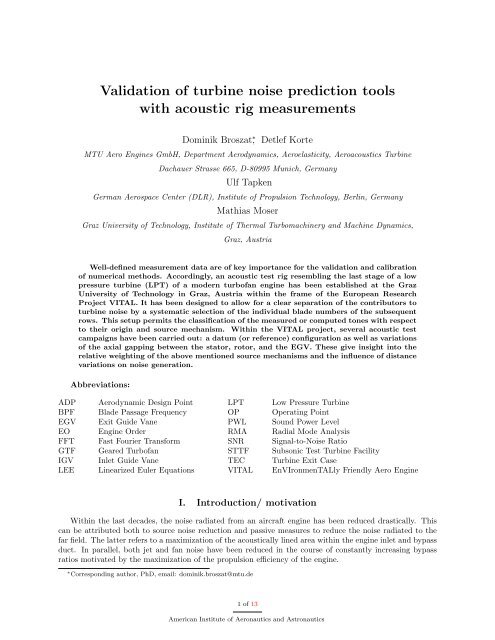


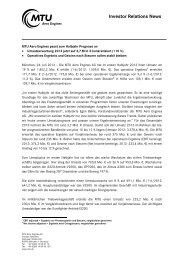
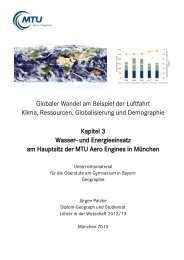
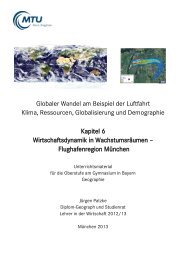
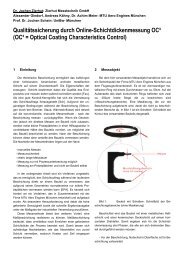
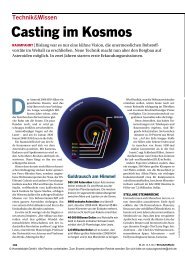

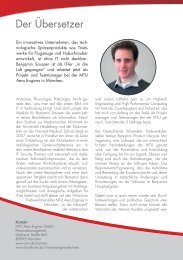
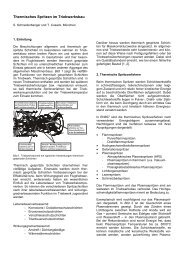
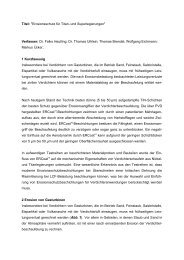


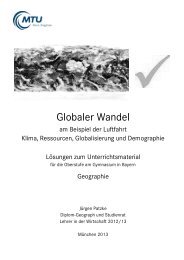
![Download PDF [5,37 MB] - MTU Aero Engines](https://img.yumpu.com/21945461/1/190x125/download-pdf-537-mb-mtu-aero-engines.jpg?quality=85)